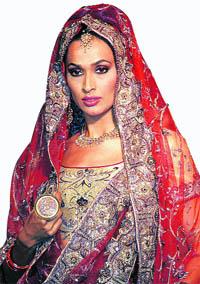|
Elegance with zari
Look chic and fashionable in zari attire, says
Banalata Bipani
Champa
Swaminathan
travelled all the way from Delhi to Chennai to shop for the
famous Kanjeevaram silk saris for her sonís wedding this
winter. Her budget was Rs 50,000 for five saris, but her bill,
even after much haggling, was Rs 68,000. "You could have
bought these within your budget six months ago. Prices have shot
up in the past couple of months after the gold price shot
up," the salesman told her. Y M Narayanaswamy, president,
Handloom Silk Cloth Manufacture and Sales Association,
Kancheepuram, said a wedding sari has about 450 grams of zari.
"We used to weave saris for Rs 15,000 six months ago, but
now it costs us Rs 37,000 to Rs 40,000."

Zari is mainly produced in Surat, Bareilly, Varanasi, Agra and Jaipur |
Same was the
problem with Mrinalini Ajgaonkar, who was keen to gift her new
bride with a classic Paithani sari, embellished with zari, and
went to the town of Paithan, 50 km from Aurnagabad. But she
found that the prices had gone beyond her purchasing power.
"Today, zari is available for Rs 58,140 per kg, which was
priced at Rs 22,000 per kg last year. The silk prices, too, have
shot up and the yarn is now available for around Rs 3,000 per
kg," says a worried Alka Manjrekar, the divisional manager
of the Maharashtra Small-Scale Industries Development
Corporation (MSSIDC), which runs the only Paithani training
centre in the country at Paithan. Mrinalini had to opt out for a
simpler type of Paithani sari known as Narali Paithani, costing
about Rs 24,000, instead of the superior mor bangdi
design, which would now cost as much as Rs 50,000 rupees. Last
year she could have bought the mor bangdi design sari for Rs
24,000.
In the last six
years (from 2005) the price of gold has increased from Rs 640
per gram to Rs 2800 a gm; silver from Rs 10 a gram to Rs 65;
silk from Rs 600 a kilo to Rs 3,500 a kilo; and even copper has
doubled from Rs 180 a kilo to Rs 600. Zari bought by weavers in
Kanchipuram or Benares comes in spools (known as a Marc of zari
weighing 242 grams), about 19,200 metres in length and with zari
thread thickness of about .3 mm! One marc of real pure gold zari,
which cost Rs 3150 in 2005, would cost nearly Rs 13,000 today.
The quantity of
the precious metal in zari thread varies from source to source.
The market is full of fake zari. In the fakes, the precious
metals are substituted by white metal or impure silver and is
available for just Rs 250-300 per marc! Even here, fake sari
manufacturers use two-ply silk instead of three-ply for weaving,
bringing down the cost and quality drastically. Of course,
imitation zari is facing some increase in demand on account of a
huge price difference compared to zari made from real metals.
Similarly, polyester film, another commonly used substitute, is
much cheaper than copper required for zari.
When you choose
a zari silk sari, what are the chances of it being genuine zari?
Quite slim, according to a survey done, and the survey results
showed that 60 per cent of zaris are fake. The fake zari racket
is rampant all over India, with 78 per cent of saris sold in
Chennai being counterfeit, followed by Hyderabad (69 per cent)
and Mysore (45 per cent).
The bulk of
Zari made in India (worth Rs 1100 crore) is in Surat. About 55
per cent of these zari raw materials is catered by Surat. Other
than Surat, some quantity of zari is also produced at Bareilly,
Varanasi, Agra, Jaipur and Barmer. But the bulk of the
consumption of zari is in South India.
Surat zari
industry dates back to as early as 16th century. Surveys by the
Government of India show that there are at least 500 composite
or semi-composite manufacturing units in Surat alone. This
apart, there are around 3000 small household units making zari
in Surat. The zari produced is known as real zari, imitation
zari and plastic zari. Real zari is made of silver and
electroplated with gold; imitation zari is made from copper;
and plastic zari, which is made from metallic yarn.
In olden days
the making of zari was always done with pure silver wires
created with real gold leaves. This was known as kalabattu.
Well-known products of the Indian zari industry besides gold and
silver thread (zari kasab) are the embroidery materials
like stars and spangles, chalak, champo, kinari, salma
and badla used in the different exportable zari
handicraft.
For the Indian customer, who
wants to buy genuine pure zari saris, the only way is to buy
from a reliable shop. For example, Nalli Silks, the famous sari
shop of Madras that has about Rs 900 crores of annual turnover,
guarantees a 60 per cent silver content in the zari used in its
saris. As yet the special zari-test machine made by the Tamil
Nadu Zari factory is not being used by most of the well-known
sari shops in India, which feel offended, at any suggestion,
that the quality of their zari saris could be doubted. ó MF
|